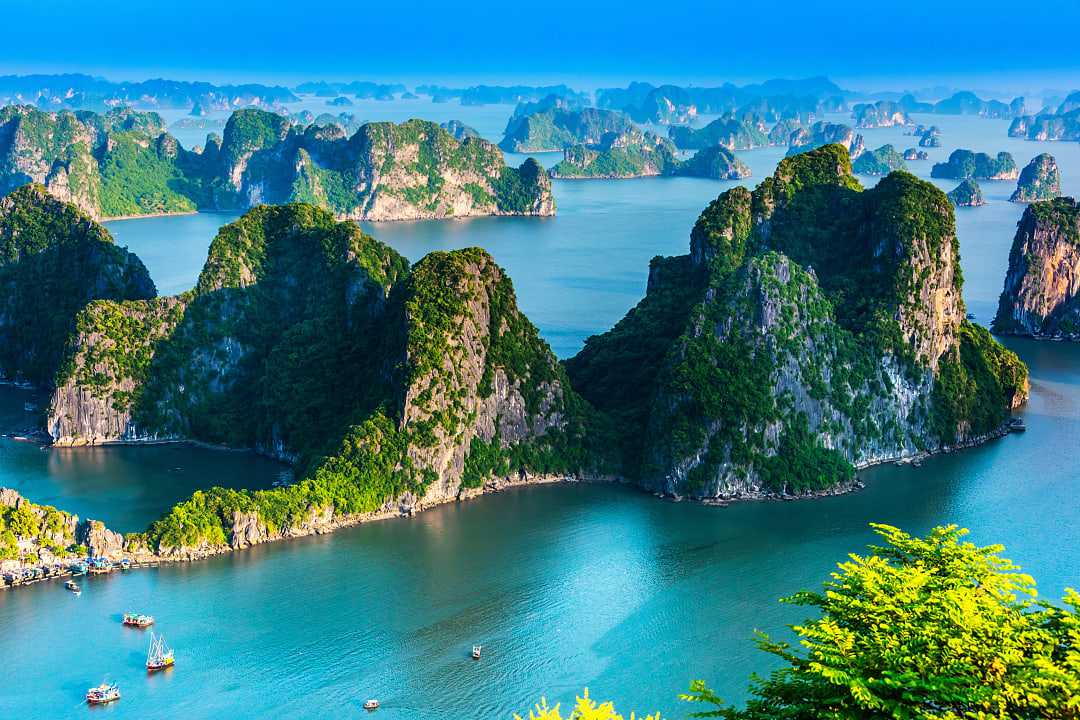A UNESCO World Heritage Site, Ha Long Bay is one of Vietnam’s most famous and stunning locations. Only 170 kilometers (105 miles) from Hanoi, in the northern Vietnamese province of Quang Ninh, lies Ha Long Bay, renowned for its emerald waters, thousands of limestone karsts and islets, and substantial cultural and historical value. Whether your goals are leisure, adventure, or cultural discovery, Ha Long Bay provides a once-in-a-lifetime experience.
1. Landscape and Geography
There are around 2,000 limestone islands and islets scattered throughout the roughly 1,553 square kilometer Ha Long Bay, many of which are deserted. Natural processes have sculpted these karsts over millions of years, resulting in a breathtaking seascape of beaches, lagoons, cliffs, and caverns.
Definition of Ha Long: “Ha Long” means “Descending Dragon” via translation. Legend has it that the bay was created when dragons used their tails to make the islands as they descended from the sky to defend Vietnam against invaders.
2. World Heritage Status by UNESCO
Ha Long Bay’s exceptional natural beauty and geological significance earned it recognition as a UNESCO World Heritage Site in 1994. Since the bay is a living example of karst formation in a tropical setting, it was further recognized in 2000 for its geomorphological significance.
3. The Best Places to See in Ha Long Bay
a. Surprise Cave, also known as Sung Sot Cave
With two enormous chambers brimming with stalactites and stalagmites, this cave is among the biggest and most exquisite in Ha Long Bay.
The cave, which provides breathtaking views of the bay, is reachable via a short stroll on Bo Hon Island.
c. Ti Top island
renowned for its expansive vista and sandy beach. Visitors are rewarded with stunning views of the bay after a quick trek to the summit.
In honor of the 1962 visit by Russian cosmonaut Gherman Titov, the island bears his name.
c. Bai Tu Long Bay
Bai Tu Long, which is northeast of Ha Long Bay, is less crowded and provides a more serene experience with comparable breathtaking scenery.
d. Cat Ba island
Cat Ba-the bay’s largest island, is well-known for its varied ecosystems, national park, and adventurous pursuits including rock climbing and trekking.
In addition, the island boasts immaculate beaches and a bustling town with lodging and dining options.
e. Luon Cave
A water cave encircled by tall cliffs and dense vegetation that is only accessible by kayak or small boat.
f. Floating Villages
The lives of the local fisherman who have been residing on the bay for many centuries can be seen in traditional fishing towns like Cua Van and Vung Vieng.
4. Activities in Ha Long Bay
a. Cruising
- A cruise is the best way to explore Ha Long Bay. Options range from day trips to luxurious overnight cruises.
- Activities on cruises often include kayaking, swimming, squid fishing, and cooking classes.
b. Kayaking
- Paddle through hidden lagoons, caves, and around karsts to experience the bay up close.
- Popular kayaking spots include Luon Cave, Ba Hang Fishing Village, and Dark and Bright Cave.
c. Hiking
- Climb to the top of Ti Top Island or trek through Cat Ba National Park for stunning views and a chance to explore the region’s biodiversity.
d. Swimming and Relaxing
- Many islands in Ha Long Bay feature sandy beaches perfect for swimming and sunbathing, such as Ti Top Beach and Soi Sim Beach.
e. Exploring Caves
- Discover the magical formations inside caves like Sung Sot Cave, Dau Go Cave, and Thien Cung Cave.
5. Best Time to Visit
The best time to visit Ha Long Bay depends on your preferences for weather and activities:
- Spring (March to May): Mild temperatures (20–30°C) and clear skies make this the ideal time for sightseeing and outdoor activities.
- Autumn (September to November): Similar to spring, with pleasant weather and fewer tourists.
- Summer (June to August): Warm and humid, with occasional rain. This is the best time for swimming and water activities, though it’s also peak tourist season.
- Winter (December to February): Cooler temperatures (15–20°C) and misty mornings create a mystical atmosphere, though it may not be ideal for swimming.
6. How to Get to Ha Long Bay
- From Hanoi:
- By bus: Regular buses and luxury vans operate between Hanoi and Ha Long City, taking about 2.5-3 hours.
- By car: Private car services are available for a more comfortable journey, taking about 2-2.5 hours.
- By seaplane: A scenic 45-minute flight from Hanoi offers aerial views of the bay.
7. Accommodation Options
Ha Long Bay offers a wide range of accommodations, from budget-friendly to luxurious:
- Cruise Ships: Stay overnight on a cruise to wake up surrounded by the bay’s beauty. Recommended options include Paradise Cruises, Orchid Cruises, and Heritage Line.
- Hotels in Ha Long City: For those who prefer staying on land, options include Wyndham Legend Halong and Vinpearl Resort & Spa Ha Long.
- Eco-Lodges: Stay in eco-friendly accommodations on Cat Ba Island for a unique experience.
8. Tips for Visiting Ha Long Bay
- Choose the Right Cruise: Decide between a day trip, overnight cruise, or multi-day cruise based on your schedule and budget.
- Pack Essentials: Bring sunscreen, a hat, swimwear, and comfortable shoes for hiking and exploring.
- Book in Advance: Cruises and accommodations can fill up quickly during peak seasons.
- Respect the Environment: Follow sustainable tourism practices to help preserve the bay’s natural beauty.
–>Why Visit Ha Long Bay?
Travelers are drawn to Ha Long Bay by its ethereal beauty, vibrant culture, and limitless adventure opportunities. Whether you’re kayaking into secret lagoons, visiting historic caverns, or cruising through emerald waters, Ha Long Bay is sure to provide an unforgettable wonderful experience.
Come see why Ha Long Bay is one of the most breathtaking natural beauties in the world!


Comment (0)